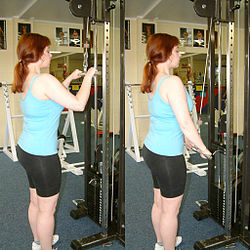Exercise
The human body adapts itself to changes in nutritional intake. If the calorie intake is reduced, the body responds by slowing down its metabolism, and by burning muscle in preference to fat.[ citation needed ] This reduces the metabolism long-term. When the diet comes to an end and normal calorie intake is restored, the individual starts to gain weight even faster than before. This is known as yo-yo dieting. Diets that focus exclusively on calorie reduction often fail in this way.[ citation needed ]
With these concerns in mind, Body for Life addresses energy expenditure (i.e. exercise) in addition to energy input. For best results, Body for Life holds that this exercise should include weight training to build skeletal muscle and increase the metabolism over the long term. This also helps to maximise the energy expenditure and fat loss from aerobic exercise. [1]
Body for Life's exercise program is more complicated than its diet program. It suggests exercising six days a week, normally Monday to Saturday, for 45 minutes and alternating between weight training and aerobic exercise. The seventh day, usually Sunday, is a rest day (referred to as the "free day", during which no exercise is done and unhealthy, normally fatty foods may be eaten). Weight training sessions alternate between exercises for the upper body and exercises for the lower body. This allows the exercised muscles enough time to recover fully before the next training session. [1] Each fortnight follows the same pattern:
Intensity index
Body for Life uses Gunnar Borg's Rating of Perceived Exertion (known as the Borg scale) for assessing the intensity of exercise based on how hard you feel you are working. It uses the variant developed by the American College of Sports Medicine, which uses a scale of 0 to 10:
- 0 is no exertion at all.
- 2 corresponds to very light exercise. For a healthy person, this is like walking slowly at their own pace for several minutes.
- 5 on the scale is somewhat hard exercise, but it still feels OK to continue.
- 8 is very strenuous. A healthy person can still go on, but they really have to push themselves. It feels very heavy, and the person is very tired.
- 9 on the scale is an extremely strenuous exercise level. For most people this is the most strenuous exercise they have ever experienced.
- 10 is maximal exertion: an all-out, 100% effort.
These levels accommodate differences in fitness. An unfit individual may require a level 10 effort to walk briskly uphill, whereas for a competitive athlete this may only be a level 3 effort. Over the course of the 12-week Body for Life program an individual would get noticeably fitter, so their intensity scale needs to be adjusted over time.
Body for Life uses a "wave" pattern, periodically building up from level 5 to level 9 or 10 during an exercise session. This allows the muscles to warm up, and gives the body a chance to build up to a "high point" of maximal exertion. Brief but intense exercise provides maximum stimulus for the body to build strength and endurance, but without the risk of overtraining. [1]
Weight training

Exercises for upper-body muscle groups include:
- "Pecs" (chest), e.g., bench press, pec-deck, incline fly.
- "Lats" (upper back), e.g., pull-down, bent-over row, dumbbell pullover.
- Deltoids (shoulders), e.g., upright row, shoulder press, lateral raise.
- Triceps (rear arms), e.g., push-down, triceps kickback, bench dip.
- Biceps (front arms), e.g., biceps curl, concentration curl, hammer curl.
Exercises for lower-body muscle groups include:
- Quadriceps (front legs), e.g., squat, leg press, leg extension.
- Hamstrings (rear legs), e.g., leg curl, lunge, glute-ham raise.
- Calves e.g., standing calf raise, seated calf raise.
- "Abs" (torso), e.g., crunch, reverse crunch, leg raise.
Most of these exercises can be performed using either dumbbells, a barbell, a Smith machine, a cable machine with adjustable pulleys or a specially designed apparatus. Two exercises should be chosen for each muscle group. Five sets of the first exercise are performed, and then one set of the second. Weights for each set should be chosen so that the specified number of repetitions can be achieved at the specified level of intensity. For example: Weight training sessions proceed at a brisk pace, with one minute of rest between the first four sets for a muscle group, and no rest between the final two sets. The cadence for each repetition should be one second to lift the weight (while exhaling deeply), one second holding it at the top, two seconds to lower the weight (while inhaling deeply) and then one second pausing before the next repetition. Each session should be completed within about 45 minutes. [1]
Aerobic exercise
Most forms of aerobic exercise are suitable. Common choices include walking or running (perhaps on a treadmill), cycling, swimming, or the use of a rowing machine or cross-trainer. However, exercise classes are generally not suitable, unless they are specifically designed to suit Body for Life.
Aerobic exercise sessions are limited to 20 minutes duration. They compensate for this by following the same "wave" pattern of steadily increasing intensity just like the weight training sessions. The aerobic, often referred to as cardio, sessions are a modified High Intensity Interval Training (HIIT).
During the first 2 minutes, intensity should be at 5. Minutes 3, 4, 5, and 6 should be at intensity levels 6, 7, 8, and 9 respectively. Minute 7 goes back down to 6 intensity level and continues the wave pattern until the 19th minute where you push intensity level to 10. The last minute is a cool down to 5 intensity. You should be completely exhausted at this point so stretch afterwards. [1]
Phillips maintains that aerobic exercise is more effective for fat loss when done first thing in the morning, because it raises the metabolism for the remainder of the day, and because the body draws more heavily on its fat stores after fasting overnight. [1]